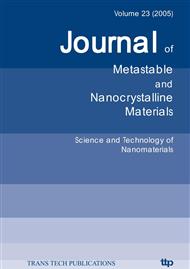[1]
M.S. Dresselhaus, G. Dresselhaus and P.C. Eklund: Science of Fullerenes and Carbon Nanotubes, (Academic Press Publications, New York 1996).
DOI: 10.1080/15363839708015913
Google Scholar
[2]
A. K. Arora, T. R. Ravindran, G. L. N. Reddy, A. K. Sikder and D. S. Misra: Diamond and Related Materials, Vol. 10 (2001), p.1477.
Google Scholar
[3]
B. V. Spitsyn, L. L. Bouilov and B. V. Derjaguin: Progress in Crystal Growth and Characterization, Vol. 17 (1988), p.79.
DOI: 10.1016/0146-3535(88)90001-9
Google Scholar
[4]
S. Iijima: Nature, Vol. 354 (1991), p.56.
Google Scholar
[5]
M. Endo, Y. A. Kim, T. Hayashi, K. Nishimura, T. Matusita, K. Miyashita and M. S. Dresselhaus: Carbon, Vol. 39 (2001), p.1287.
DOI: 10.1016/s0008-6223(00)00295-5
Google Scholar
[6]
M. Endo, Y. A. Kim, T. Takeda, S. H. Hong, T. Matusita, T. Hayashi, M. S. Dresselhaus: Carbon, Vol. 39 (2001), p. (2003).
Google Scholar
[7]
S. Motojima, M. Kawakuchi and K. Nozaki: Carbon, Vol. 29 (1991), p.379.
Google Scholar
[8]
S. Mojima, S. Kagiya and H. Iwanaga: J. Mater. Sci., Vol. 31 (1996), p.4641.
Google Scholar
[9]
X. Chen, T. Saito, M. Kusunoki and S. Motojima: J. Mater. Res., Vol. 14 (1999), p.4329.
Google Scholar
[10]
X. Chen and S. Motojima: Carbon, Vol. 37(1999), p.1817.
Google Scholar
[11]
X. Chen, S. Motojima and H. Iwanaga: Carbon, Vol. 37(1999), p.1825.
Google Scholar
[12]
X. Chen, W. In-Hwang, S. Shimada, M. Fujii, H. Iwanaga and S. Motojima: J. Mater. Res., Vol. 15 (2000), p.808.
Google Scholar
[13]
S. Motojima, Y. Kojima, T. Hamamoto, N. Ueshima and H. Iwanaga: Electrochem. Soc. Proc., Vol. 97-39 (1997), p.595.
Google Scholar
[14]
X. Chen, S. Motojima and H. Iwanaga: Carbon, Vol. 37 (1999), p.1825.
Google Scholar
[15]
S. Motojima, Y. Noda, S. Hoshiya and Y. Hishikawa: Carbon, Vol. 94 (2003), p.2325.
Google Scholar
[16]
Xinqi Chen, Sulin Zhang, Dmitriy A. Dikin, Weiqiang Ding and Rodney S. Ruoff: Nanoletters, Vol. 3 (2003), p.1299.
Google Scholar
[17]
Y. Takeuchi: Contrast media and imaging method using carbon microcoil, Jpn. Kokai Tokkyo Koho JP 2001106642. Fig. 8. SEM image of twisted nanocoils grown over iron alloy at 600-700℃. Fig. 9. A growth tip of twisted nanocoil. LLLL RRRR LLLL Fig. 7. TEM image of the single-helix spring- like coils and its electronic diffraction pattern. 200 nm Fig. 10. TEM image of a twisted nanocoil.
Google Scholar


